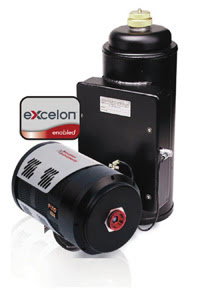CCD Technology
Teledyne Princeton InstrumentsRequest Info
 Princeton Instruments has unveiled its eXcelon deep-depletion
CCDs and cameras for low-light, near-infrared imaging and spectroscopy. Improvements
over standard deep-depletion technology include reduced etaloning and higher quantum
efficiency across a broader wavelength range, from 200 to 1100 nm. The new CCDs,
with pixel resolutions of 1340 x 100, 1340 x 400, 1024 x 1024 and 1340 x 1300, are
available in the company’s Pixis and Spec-10 deep-cooled, low-noise camera
platforms. The sensors deliver peak quantum efficiency of >95% and as much as
a 45% increase over a broader UV-NIR wavelength range. They are suitable for use
in live-cell imaging, confocal imaging, total internal reflection fluorescence,
Förster resonance energy transfer and superresolution techniques, including
stochastic optical reconstruction microscopy and photoactivated localization microscopy.
Princeton Instruments has unveiled its eXcelon deep-depletion
CCDs and cameras for low-light, near-infrared imaging and spectroscopy. Improvements
over standard deep-depletion technology include reduced etaloning and higher quantum
efficiency across a broader wavelength range, from 200 to 1100 nm. The new CCDs,
with pixel resolutions of 1340 x 100, 1340 x 400, 1024 x 1024 and 1340 x 1300, are
available in the company’s Pixis and Spec-10 deep-cooled, low-noise camera
platforms. The sensors deliver peak quantum efficiency of >95% and as much as
a 45% increase over a broader UV-NIR wavelength range. They are suitable for use
in live-cell imaging, confocal imaging, total internal reflection fluorescence,
Förster resonance energy transfer and superresolution techniques, including
stochastic optical reconstruction microscopy and photoactivated localization microscopy.
https://www.princetoninstruments.com
/Buyers_Guide/Teledyne_Princeton_Instruments/c12186
Published: November 2010
REQUEST INFO ABOUT THIS PRODUCT
* First Name:
* Last Name:
* Email Address:
* Company:
* Country:
Message:
When you click "Send Request", we will record and send your personal contact information to Teledyne Princeton Instruments by email so they may respond directly. You also agree that Photonics Media may contact you with information related to this inquiry, and that you have read and accept our
Privacy Policy and
Terms and Conditions of Use.
Register or login to auto-populate this form:
Login
Register
* Required